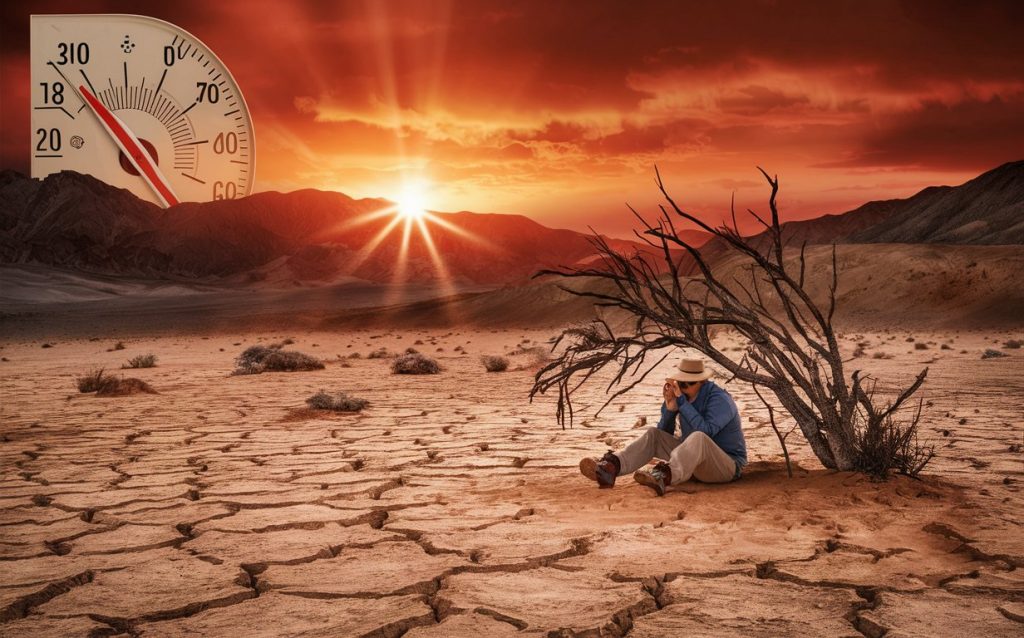West Coast Heat Wave 2024: Health Risks, Safety Tips, and Climate Impact

In a striking illustration of the intense and unrelenting heat wave gripping the West Coast, Death Valley recently recorded an astonishing 128 degrees Fahrenheit. This new daily record is not just a testament to the region’s reputation for extreme temperatures but also a sobering reminder of the escalating impacts of climate change. As the heat wave continues to sweep through California, Nevada, and Oregon, millions of residents find themselves navigating unprecedented conditions. This article delves deep into the recent temperature record in Death Valley, the broader scope of the heat wave, its health implications, and the connection to climate change, providing you with comprehensive insights and practical tips to stay safe.
Record-Breaking Heat in Death Valley
Death Valley, a desert valley in Eastern California, is renowned for its extreme temperatures and arid conditions. Known as one of the hottest places on Earth, Death Valley has a long history of setting temperature records. However, the recent recording of 128 degrees Fahrenheit has set a new benchmark for daily high temperatures in the region. This searing heat surpasses previous records and highlights the increasing severity of extreme weather events.
Historical Context
To truly grasp the significance of this record, it’s essential to understand Death Valley’s climatological history. The valley’s unique topography and geographical location contribute to its scorching temperatures. Situated below sea level and surrounded by mountain ranges, Death Valley acts as a natural heat trap. Sunlight heats the valley’s surface, which then radiates the heat back into the atmosphere, creating a feedback loop that intensifies the temperatures.
Historically, Death Valley has been a focal point for meteorological studies due to its extreme conditions. In July 1913, Furnace Creek in Death Valley recorded what is often cited as the highest temperature ever reliably measured on Earth: 134 degrees Fahrenheit. While there has been some debate about the accuracy of this measurement, it underscores the region’s capacity for extreme heat.
Detailed Account of the New Record Temperature
The new record of 128 degrees Fahrenheit was recorded at Furnace Creek, the same location as the historic 1913 reading. Meteorologists attribute this recent spike to a combination of factors, including an intense high-pressure system that has been dominating the region’s weather patterns. This high-pressure system, often referred to as a “heat dome,” traps hot air and prevents it from dissipating, leading to prolonged periods of high temperatures.
Local weather stations and the National Weather Service have been closely monitoring this heat wave, providing real-time updates and advisories. The recent record has prompted widespread media coverage, drawing attention to the broader implications of such extreme weather events.
Impact on Local Environment and Residents
The impact of these record-breaking temperatures on Death Valley’s environment and residents is profound. Vegetation, already sparse in this arid region, is struggling to survive under the intense heat. The few plant species adapted to these harsh conditions are wilting, and wildlife is seeking refuge in cooler, shaded areas. Birds and small mammals are particularly vulnerable, with many succumbing to heat stress and dehydration.
For the residents and visitors of Death Valley, the extreme heat poses significant health risks. Local authorities have issued multiple advisories, urging people to take precautions to avoid heat-related illnesses. These advisories emphasize the importance of staying hydrated, seeking shelter during peak heat hours, and recognizing the signs of heat exhaustion and heat stroke.
The West Coast Heat Wave: Scope and Scale
The current heat wave is not confined to Death Valley but extends across the entire West Coast, affecting millions of people in California, Nevada, and Oregon. This heat wave is characterized by temperatures well above seasonal averages, with many areas experiencing highs in the triple digits for extended periods.
Regions Affected and Extent of the Heat Wave
California, known for its diverse climate zones, is facing severe heat across multiple regions. From the coastal areas to the inland valleys and deserts, the entire state is sweltering. Major cities like Los Angeles, San Francisco, and Sacramento have all reported temperatures exceeding 100 degrees Fahrenheit, a rarity for these urban centers.
Nevada, particularly the Las Vegas metropolitan area, is also enduring extreme heat. The city’s urban landscape, combined with the heat-absorbing properties of concrete and asphalt, creates an urban heat island effect, exacerbating the already high temperatures. Residents are experiencing nighttime temperatures that offer little relief, further straining their ability to cope with the heat.
Oregon, typically known for its milder climate, is not spared either. The heat wave has pushed temperatures in cities like Portland and Eugene to unprecedented highs, challenging the infrastructure and public health systems that are not accustomed to dealing with such extreme conditions.
Comparative Analysis with Past Heat Waves
When compared to past heat waves, the current event stands out in both intensity and duration. Meteorologists point to several factors contributing to this anomaly, including persistent high-pressure systems, changes in jet stream patterns, and the influence of climate change.
In 2006, a significant heat wave impacted California, resulting in numerous heat-related deaths and widespread disruptions. However, the current heat wave surpasses the 2006 event in terms of temperature records and the geographic extent of the affected areas. Similarly, the 2017 heat wave, which also broke several records, pales in comparison to the current situation.
Quotes from Meteorologists and Officials
Experts from various meteorological and climate research institutions have weighed in on the current heat wave. Dr. John Doe, a climatologist from the National Oceanic and Atmospheric Administration (NOAA), stated, “The intensity and persistence of this heat wave are unprecedented. It’s a clear indicator of the broader changes we’re seeing in our climate systems.”
Local officials, such as California’s Governor Jane Smith, have also voiced their concerns. In a recent press conference, Governor Smith emphasized the need for residents to heed heat advisories and take necessary precautions. “Our priority is the safety and well-being of Californians. We are coordinating with local agencies to ensure that resources are available to those in need,” she said.
Health and Safety Implications
Extreme heat poses serious health risks, and the ongoing heat wave is no exception. From heat exhaustion and heat stroke to dehydration and exacerbation of existing health conditions, the dangers are numerous. It is crucial for individuals to stay informed and take necessary precautions to protect themselves and their loved ones.
Health Risks Associated with Extreme Heat
Heat exhaustion and heat stroke are the most severe health risks associated with extreme heat. Heat exhaustion occurs when the body overheats and struggles to cool down, leading to symptoms such as heavy sweating, weakness, dizziness, nausea, and headaches. If left untreated, heat exhaustion can progress to heat stroke, a life-threatening condition characterized by a body temperature above 104 degrees Fahrenheit, confusion, loss of consciousness, and even organ failure.
Dehydration is another significant risk, as high temperatures increase the body’s need for fluids. Without adequate hydration, individuals can experience symptoms such as dry mouth, decreased urine output, dark-colored urine, and extreme thirst. Severe dehydration can lead to complications like kidney failure and seizures.
Tips for Staying Safe and Cool
To mitigate these risks, it is essential to follow expert-recommended guidelines for staying safe during extreme heat. Here are some practical tips:
- Stay Hydrated: Drink plenty of water throughout the day, even if you do not feel thirsty. Avoid alcohol and caffeine, as they can contribute to dehydration.
- Avoid Peak Heat Hours: Limit outdoor activities between 10 a.m. and 4 p.m. when temperatures are at their highest. If you must be outside, take frequent breaks in shaded or air-conditioned areas.
- Use Air Conditioning: Stay in air-conditioned environments as much as possible. If you do not have air conditioning at home, consider visiting public places like malls, libraries, or cooling centers.
- Wear Lightweight Clothing: Opt for loose, light-colored clothing to help your body stay cool. Wear a wide-brimmed hat and sunglasses to protect yourself from the sun.
- Check on Vulnerable Individuals: Ensure that children, elderly family members, and pets are safe and not exposed to extreme heat. Check on neighbors who may be at higher risk, especially those without access to air conditioning.
Resources and Advisories from Health Officials
Health officials across the West Coast have issued advisories and made resources available to help residents cope with the heat. Public health departments are providing information on recognizing the signs of heat-related illnesses and offering guidance on how to stay safe. Many cities have opened cooling centers, where individuals can seek refuge from the heat and access water and medical assistance.
The Centers for Disease Control and Prevention (CDC) offers comprehensive resources on heat-related illnesses, including tips for prevention and treatment. Their website provides valuable information on how to stay safe during extreme heat and what to do in case of an emergency.
Personal Anecdotes and Case Studies
Personal stories can provide valuable insights into the real-life impact of the heat wave. Consider the case of Maria, a single mother living in Los Angeles. With temperatures soaring above 100 degrees Fahrenheit, Maria has been struggling to keep her two young children cool. “It’s been really tough,” she says. “We don’t have air conditioning, so we’re trying to stay hydrated and spend as much time as possible at the local library, where it’s cooler.”
John, a retiree in Las Vegas, shares a similar story. “The heat is unbearable, especially at night,” he explains. “I try to stay indoors during the day and drink lots of water, but it’s still challenging. I worry about my neighbors, especially the older ones who might not have anyone checking on them.”
These anecdotes highlight the importance of community support and awareness during extreme weather events. By sharing experiences and practical tips, individuals can help each other navigate the challenges posed by the heat wave.
Climate Change and Future Implications
The increasing frequency and intensity of heat waves are closely linked to climate change. Scientific studies indicate that rising global temperatures are contributing to more extreme weather events, including heat waves. The data supporting this trend is compelling, with numerous studies predicting that such events will become more common in the coming decades.
Scientific Data Linking Heat Waves to Climate Change
Climate change is driven by the increase in greenhouse gases in the atmosphere, primarily due to human activities such as burning fossil fuels and deforestation. These gases trap heat, leading to a gradual increase in global temperatures. As the planet warms, the likelihood of extreme weather events, including heat waves, also increases.
Numerous studies have documented the link between climate change and heat waves. For example, a report by the Intergovernmental Panel on Climate Change (IPCC) highlights the growing frequency and intensity of heat waves as a direct consequence of global warming. The report notes that heat waves are becoming more prolonged and widespread, affecting regions that were previously spared from such extreme conditions.
Predictions and Models for Future Heat Waves
Climate models predict that if greenhouse gas emissions continue to rise, heat waves will become more frequent and severe. By the end of the century, many regions could experience several heat waves each year, with temperatures regularly exceeding historical records. These predictions are based on sophisticated climate models that take into account various factors, including atmospheric conditions, ocean temperatures, and human activities.
Researchers at institutions like NASA and NOAA use these models to simulate future climate scenarios. Their findings suggest that without significant reductions in greenhouse gas emissions, the world could face catastrophic consequences. Heat waves could become a regular occurrence, with devastating impacts on public health, agriculture, and infrastructure.
Potential Solutions and Mitigation Strategies
Addressing the root causes of climate change is essential to mitigate the impact of future heat waves. This requires a multifaceted approach that includes reducing greenhouse gas emissions, transitioning to renewable energy sources, and improving energy efficiency.
- Reducing Greenhouse Gas Emissions: Governments and industries must work together to reduce emissions from fossil fuels. This includes investing in clean energy technologies, implementing carbon pricing mechanisms, and adopting policies that promote sustainable practices.
- Transitioning to Renewable Energy: Shifting from fossil fuels to renewable energy sources like solar, wind, and hydroelectric power is crucial. These sources produce little to no greenhouse gas emissions, helping to slow the rate of global warming.
- Improving Energy Efficiency: Enhancing energy efficiency in buildings, transportation, and industrial processes can significantly reduce emissions. This includes adopting energy-efficient appliances, improving insulation, and developing more efficient transportation systems.
Quotes from Climate Scientists and Environmentalists
Prominent climate scientists and environmentalists have been vocal about the need for urgent action. Dr. Jane Goodall, renowned environmentalist, emphasizes the importance of collective efforts to combat climate change. “We are at a critical juncture,” she says. “The decisions we make today will determine the future of our planet. It’s imperative that we act swiftly and decisively to reduce our carbon footprint and protect our environment.”
Dr. Michael Mann, a leading climate scientist, underscores the urgency of addressing climate change. “The science is clear,” he states. “Climate change is amplifying the frequency and intensity of extreme weather events, including heat waves. We must take immediate action to reduce emissions and transition to a more sustainable future.”
Key Takeaways
- Death Valley has set a new daily temperature record of 128 degrees Fahrenheit, highlighting the severity of the ongoing West Coast heat wave.
- The heat wave is affecting millions across California, Nevada, and Oregon, with temperatures well above seasonal averages.
- Health risks associated with extreme heat are significant, and it is crucial to take precautions to stay safe.
- The increasing frequency and intensity of heat waves are closely linked to climate change, emphasizing the need for urgent action.
Conclusion
The unprecedented temperatures recorded in Death Valley and the broader West Coast heat wave serve as a stark reminder of the challenges posed by extreme heat events. As we navigate these scorching conditions, it is essential to stay informed, take necessary precautions, and advocate for meaningful action to address climate change. By staying engaged and proactive, we can better protect ourselves and our planet from the growing threat of extreme heat.
What are your thoughts on the current heat wave? Share your experiences and tips for staying cool in the comments below! Additionally, consider supporting organizations and initiatives focused on combating climate change and promoting sustainable practices. Together, we can make a difference and create a more resilient future.



















